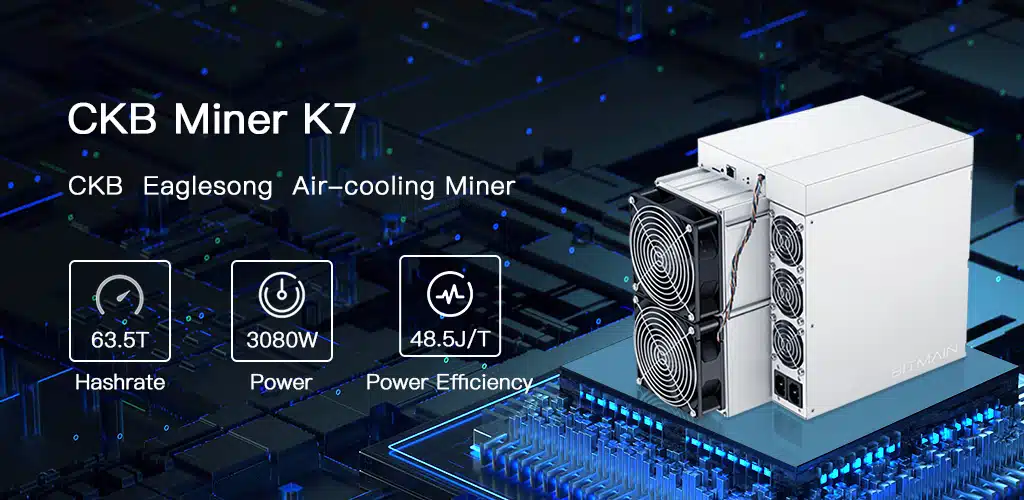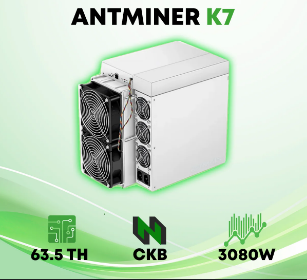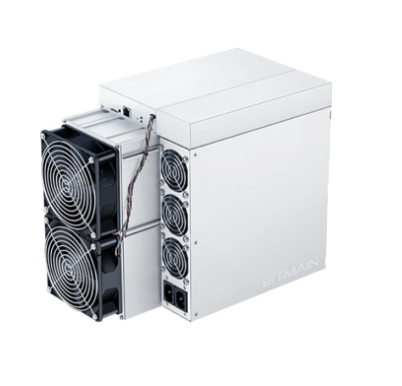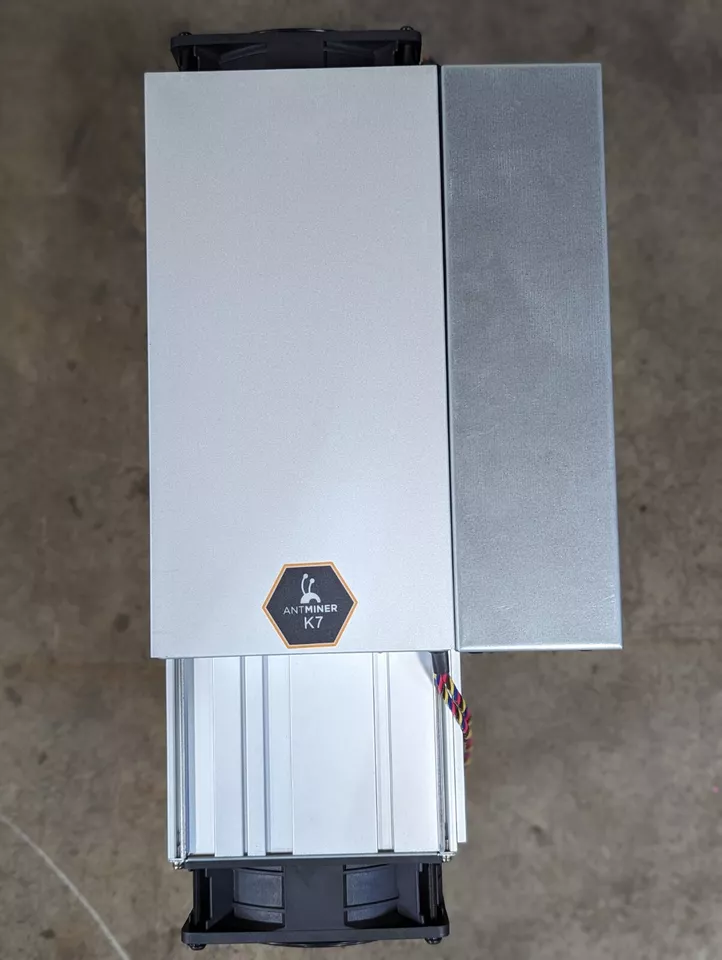How to Calculate Energy Costs for CKB Miner K7
Cryptocurrency mining is a highly competitive and energy-intensive endeavor, and understanding the energy costs associated with your mining equipment is crucial for maximizing profitability. The CKB Miner K7, a state-of-the-art mining solution designed for the Eaglesong algorithm, offers exceptional performance and efficiency. However, to fully leverage its potential, miners must accurately calculate and manage their energy expenses. This article will guide you through the process of calculating energy costs for the CKB Miner K7, providing practical insights and actionable steps to optimize your mining operations.
Understanding the CKB Miner K7
Before diving into energy cost calculations, it’s essential to understand the key specifications of the CKB Miner K7 that directly impact energy consumption:

- Hashrate: 63.5 TH/s (±3%)
- Power Consumption: 3080W (±5%)
- Power Efficiency: 48.5 J/TH at 25°C ambient temperature
- Operating Voltage: Dual AC input (200-240V, 50-60Hz)
The K7’s high hashrate and energy-efficient design make it a standout choice for CKB mining. However, its power consumption of 3080W means that energy costs can significantly affect overall profitability. By calculating these costs, miners can make informed decisions about their operations, such as choosing cost-effective electricity rates or optimizing mining schedules.
Step 1: Determine Your Electricity Rate
The first step in calculating energy costs is to determine your electricity rate, typically measured in kilowatt-hours (kWh). Electricity rates vary widely depending on your location, provider, and usage tier. For example:
- Residential rates: $0.10 to $0.30 per kWh
- Commercial/industrial rates: $0.05 to $0.15 per kWh
- Renewable energy or off-peak rates: Potentially lower costs
To find your exact rate, check your electricity bill or contact your provider. If you’re operating in a region with variable rates (e.g., time-of-use pricing), consider averaging the rates over a typical day or week.
Step 2: Calculate Daily Energy Consumption
The CKB Miner K7 consumes 3080W of power. To calculate daily energy consumption, use the following formula:
Daily Energy Consumption (kWh) = Power Consumption (kW) × Hours of Operation
Since the K7 is designed for continuous operation, we’ll assume it runs 24 hours a day:
Daily Energy Consumption = 3.08 kW × 24 hours = 73.92 kWh
This means the K7 consumes approximately 73.92 kWh of electricity each day.
Step 3: Calculate Daily Energy Costs
Next, multiply the daily energy consumption by your electricity rate to determine daily energy costs:
Daily Energy Cost = Daily Energy Consumption (kWh) × Electricity Rate ($/kWh)
For example, if your electricity rate is $0.12 per kWh:
Daily Energy Cost = 73.92 kWh × $0.12/kWh = $8.87
This calculation shows that running the K7 for 24 hours costs $8.87 in electricity.
Step 4: Project Monthly and Annual Energy Costs
To understand the long-term impact of energy costs, project them over a month and a year:

Monthly Energy Cost = Daily Energy Cost × 30 days Annual Energy Cost = Daily Energy Cost × 365 days
Using the previous example:
Monthly Energy Cost = $8.87 × 30 = $266.10 Annual Energy Cost = $8.87 × 365 = $3,237.55
These projections highlight the importance of managing energy costs, as they can significantly impact your mining profitability.
Step 5: Factor in Cooling and Infrastructure Costs
While the above calculations focus on the miner’s direct energy consumption, it’s also important to account for additional energy costs, such as cooling and infrastructure. Mining equipment generates significant heat, and maintaining optimal operating temperatures requires additional energy for cooling systems.
For example, if your cooling system consumes an additional 1000W:

Daily Cooling Energy Consumption = 1 kW × 24 hours = 24 kWh Daily Cooling Cost = 24 kWh × $0.12/kWh = $2.88
Adding this to the miner’s energy costs:
Total Daily Energy Cost = $8.87 + $2.88 = $11.75

Including these costs provides a more accurate picture of your total energy expenses.
Step 6: Optimize Energy Costs
Once you’ve calculated your energy costs, consider strategies to optimize them:
- Negotiate Lower Electricity Rates: If you’re operating at scale, negotiate with your provider for discounted rates.
- Use Renewable Energy: Solar, wind, or hydroelectric power can reduce costs and environmental impact.
- Leverage Off-Peak Rates: Schedule mining operations during periods of lower electricity rates.
- Improve Cooling Efficiency: Use energy-efficient cooling systems or deploy miners in cooler climates to reduce cooling costs.
- Monitor and Adjust: Regularly review your energy consumption and adjust operations to maximize efficiency.
Real-World Example: Comparing Energy Costs
Let’s compare the energy costs of the CKB Miner K7 in two scenarios:
- High-Cost Region: Electricity rate = $0.20/kWh
- Daily Energy Cost = 73.92 kWh × $0.20 = $14.78
- Annual Energy Cost = $14.78 × 365 = $5,394.70
- Low-Cost Region: Electricity rate = $0.08/kWh
- Daily Energy Cost = 73.92 kWh × $0.08 = $5.91
- Annual Energy Cost = $5.91 × 365 = $2,157.15
This comparison underscores the importance of location and electricity rates in determining mining profitability.
Conclusion
Calculating energy costs for the CKB Miner K7 is a critical step in optimizing your mining operations. By understanding your electricity rate, projecting daily, monthly, and annual costs, and factoring in additional expenses like cooling, you can make informed decisions to enhance profitability. The K7’s energy-efficient design and industry-leading performance make it a powerful tool for CKB mining, but managing energy costs is key to unlocking its full potential. Whether you’re a small-scale miner or a large-scale operator, these calculations will help you stay competitive in the ever-evolving world of cryptocurrency mining.